Abstract
Superoxide and other oxygen radicals produced by activated polymorphonuclear leukocytes (PMN) may be important causes of tissue damage in a number of inflammatory conditions. Therefore, a drug which suppresses PMN responses in vivo is potentially important. In vitro, pentoxifylline (PTOX) inhibits superoxide anion production when PMN are stimulated with an activated complement component (C5a Des Arg) or formyl peptides but only at concentrations not achieved in the circulation. The aim of this study was to determine whether PTOX has an effect on PMN responses in vivo. Superoxide anion production, monitored by lucigenin-enhanced chemiluminescence, was inhibited by 40.5% +/- 8.0% (n = 8, P < 0.009) for C5a Des Arg and 47.7% +/- 9.6% (n = 8, P < 0.009) for formyl-methionylleucylphenylalanine stimulation 1.5 h after ingestion of 400 mg of PTOX in a slow-release tablet, with some inhibitory effects persisting at 5 h. There was a strong correlation between reduced PMN response to activated complement and plasma concentrations of three PTOX metabolites (P < 0.05), but not with plasma concentrations of the parent drug. In vitro investigations with each of the four methylxanthines showed two of these metabolites to be most effective at reducing PMN respiratory burst activity, lactoferrin release, and the expression of CD11b and CD18 molecules. Furthermore, this in vitro inhibitory activity was achieved at concentrations of metabolites achievable in vivo. The results suggest that PTOX reduces oxygen radical production and protects against unwanted tissue damage in vivo by the action of its metabolites.
Full text
PDF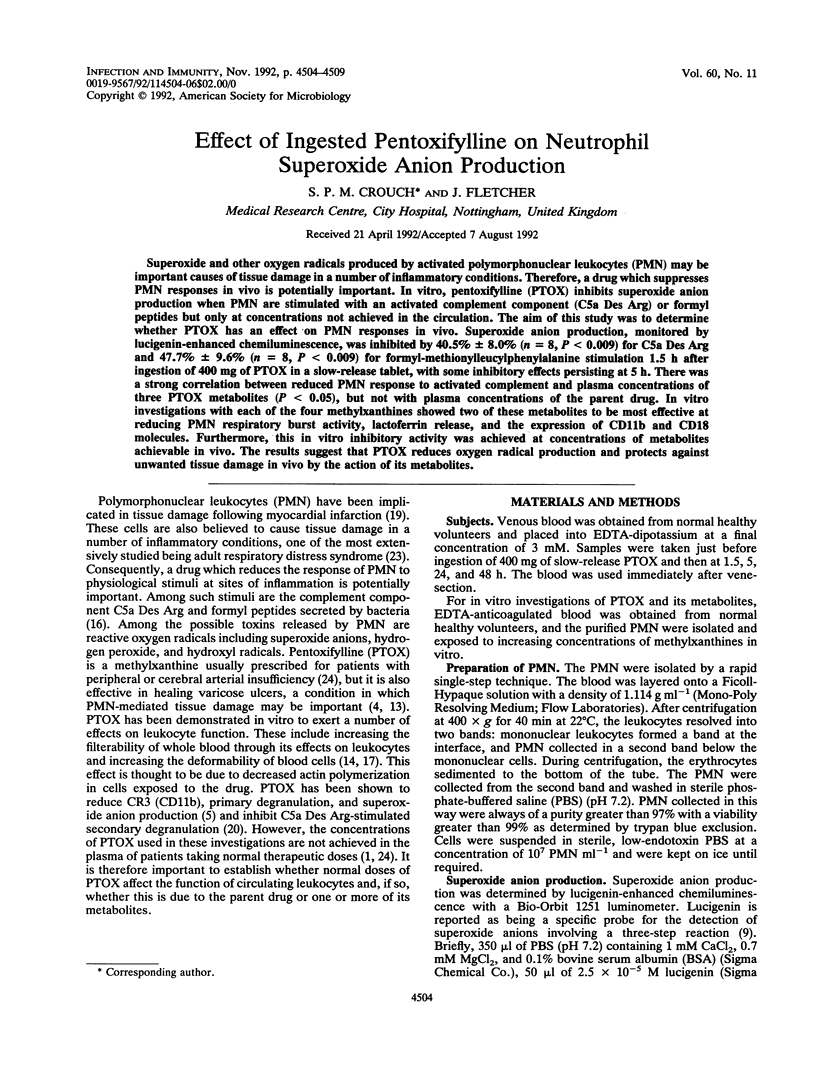

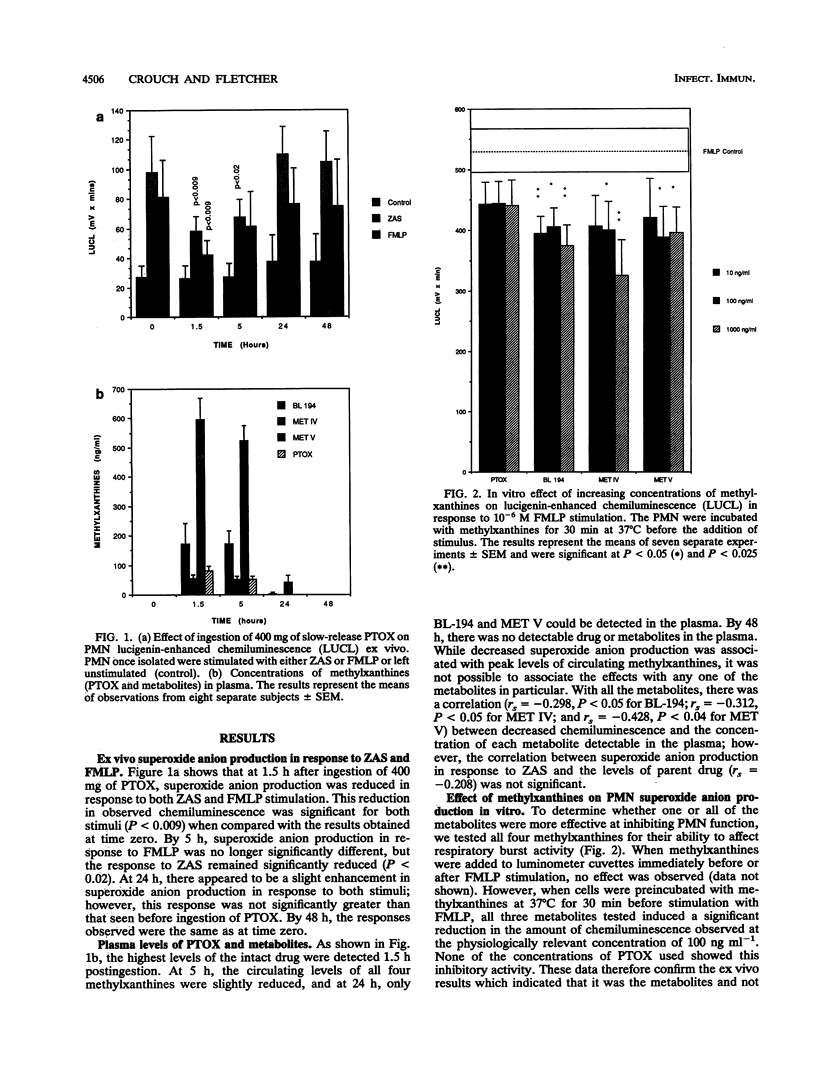
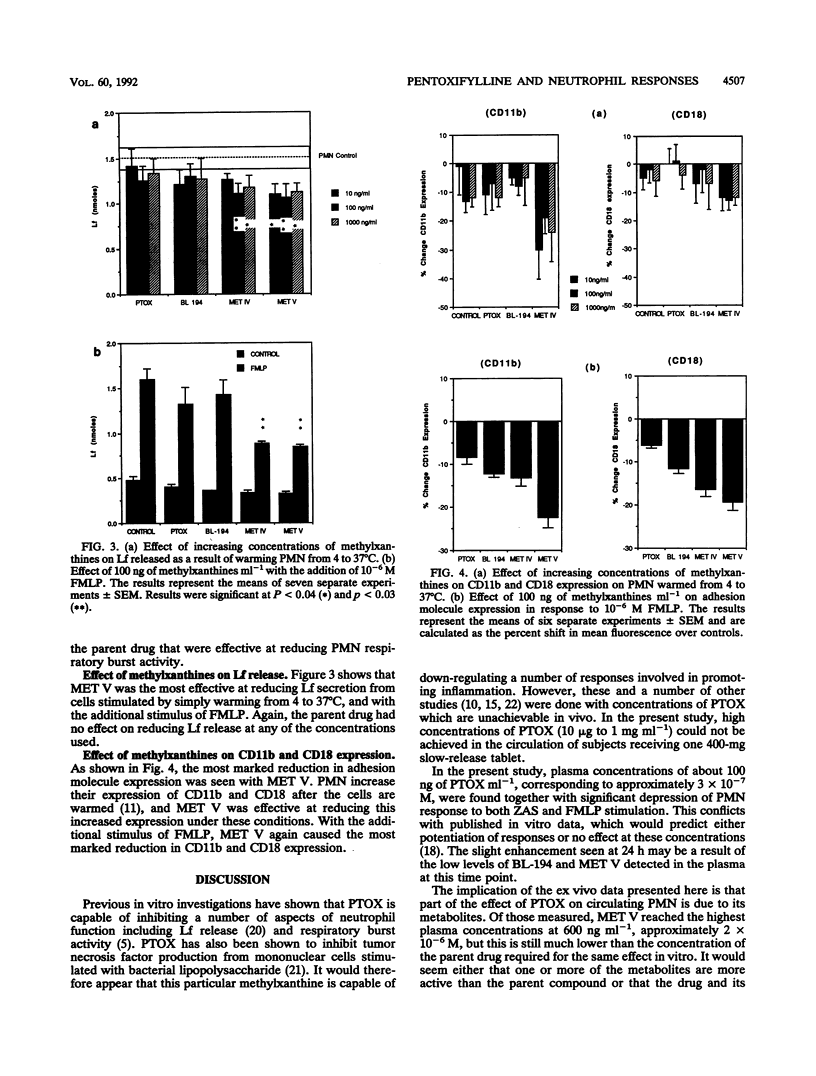
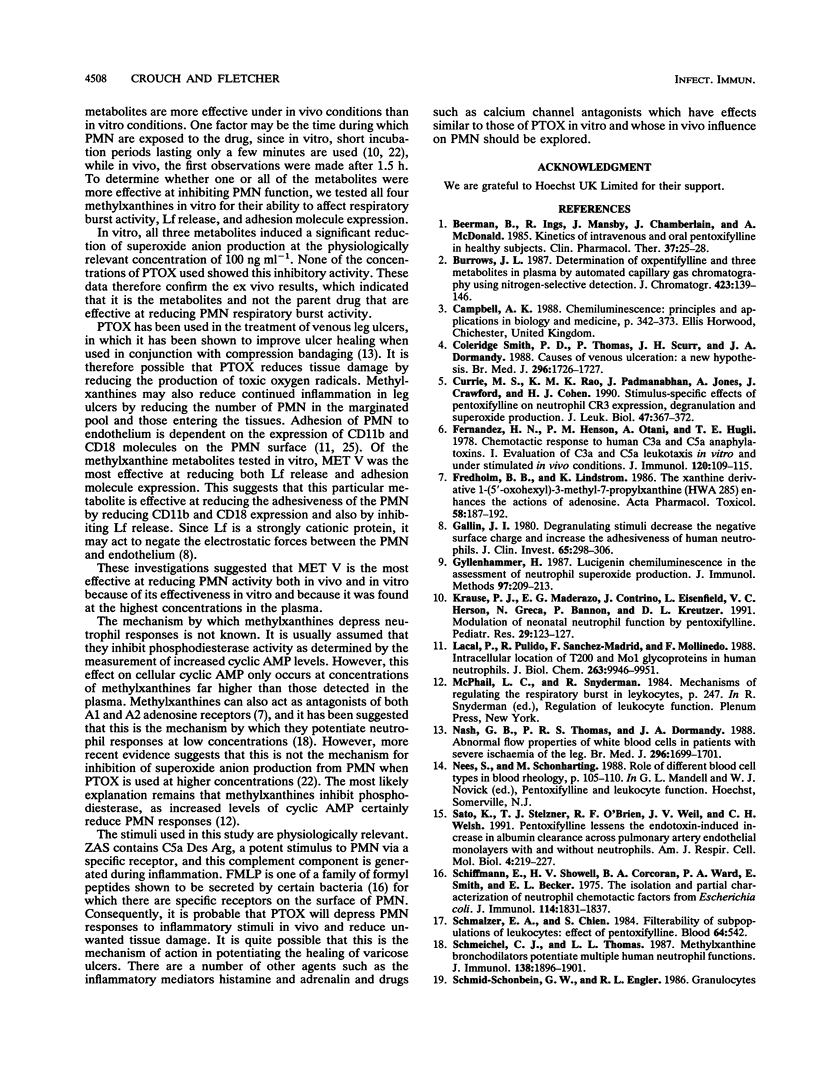
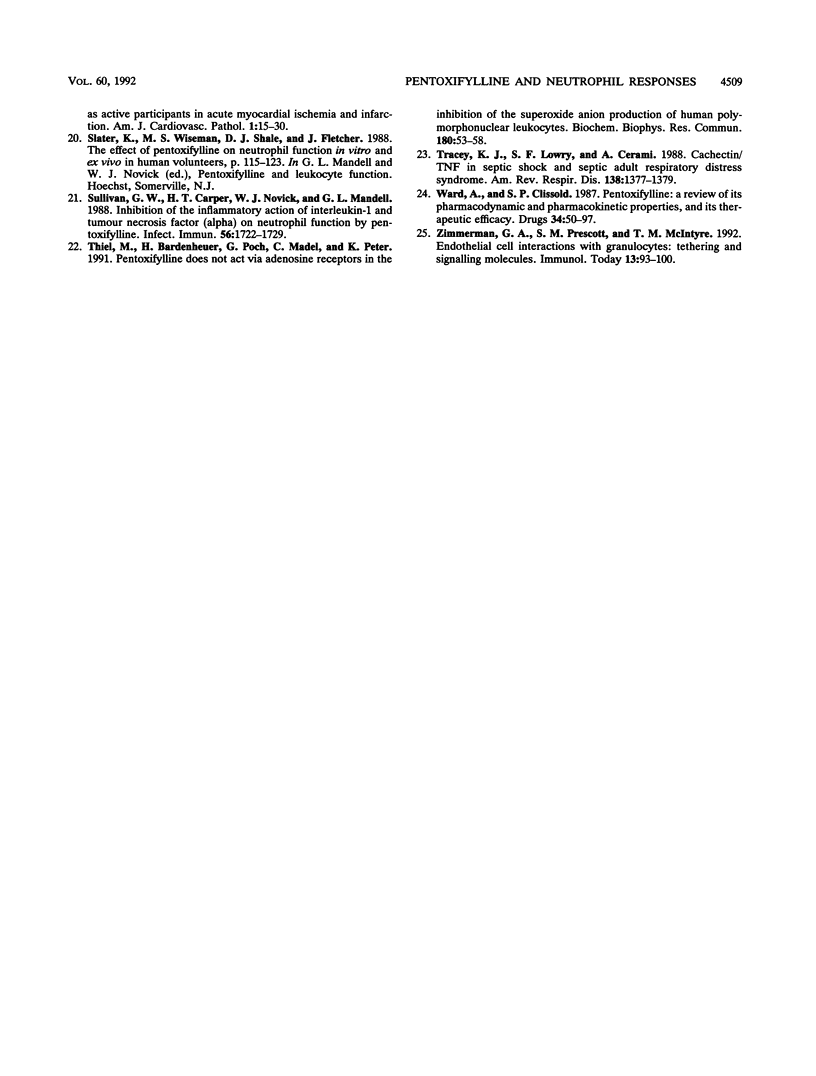
Selected References
These references are in PubMed. This may not be the complete list of references from this article.
- Beermann B., Ings R., Månsby J., Chamberlain J., McDonald A. Kinetics of intravenous and oral pentoxifylline in healthy subjects. Clin Pharmacol Ther. 1985 Jan;37(1):25–28. doi: 10.1038/clpt.1985.6. [DOI] [PubMed] [Google Scholar]
- Burrows J. L. Determination of oxpentifylline and three metabolites in plasma by automated capillary gas chromatography using nitrogen-selective detection. J Chromatogr. 1987 Dec 25;423:139–146. doi: 10.1016/0378-4347(87)80336-5. [DOI] [PubMed] [Google Scholar]
- Coleridge Smith P. D., Thomas P., Scurr J. H., Dormandy J. A. Causes of venous ulceration: a new hypothesis. Br Med J (Clin Res Ed) 1988 Jun 18;296(6638):1726–1727. doi: 10.1136/bmj.296.6638.1726. [DOI] [PMC free article] [PubMed] [Google Scholar]
- Fernandez H. N., Henson P. M., Otani A., Hugli T. E. Chemotactic response to human C3a and C5a anaphylatoxins. I. Evaluation of C3a and C5a leukotaxis in vitro and under stimulated in vivo conditions. J Immunol. 1978 Jan;120(1):109–115. [PubMed] [Google Scholar]
- Fredholm B. B., Lindström K. The xanthine derivative 1-(5'-oxohexyl)-3-methyl-7-propyl xanthine (HWA 285) enhances the actions of adenosine. Acta Pharmacol Toxicol (Copenh) 1986 Mar;58(3):187–192. doi: 10.1111/j.1600-0773.1986.tb00093.x. [DOI] [PubMed] [Google Scholar]
- Gallin J. I. Degranulating stimuli decrease the neagative surface charge and increase the adhesiveness of human neutrophils. J Clin Invest. 1980 Feb;65(2):298–306. doi: 10.1172/JCI109672. [DOI] [PMC free article] [PubMed] [Google Scholar]
- Gyllenhammar H. Lucigenin chemiluminescence in the assessment of neutrophil superoxide production. J Immunol Methods. 1987 Mar 12;97(2):209–213. doi: 10.1016/0022-1759(87)90461-3. [DOI] [PubMed] [Google Scholar]
- Krause P. J., Maderazo E. G., Contrino J., Eisenfeld L., Herson V. C., Greca N., Bannon P., Kreutzer D. L. Modulation of neonatal neutrophil function by pentoxifylline. Pediatr Res. 1991 Feb;29(2):123–127. doi: 10.1203/00006450-199102000-00002. [DOI] [PubMed] [Google Scholar]
- Lacal P., Pulido R., Sánchez-Madrid F., Mollinedo F. Intracellular location of T200 and Mo1 glycoproteins in human neutrophils. J Biol Chem. 1988 Jul 15;263(20):9946–9951. [PubMed] [Google Scholar]
- McPhail L. C., Snyderman R. Mechanisms of regulating the respiratory burst in leukocytes. Contemp Top Immunobiol. 1984;14:247–281. doi: 10.1007/978-1-4757-4862-8_9. [DOI] [PubMed] [Google Scholar]
- Nash G. B., Thomas P. R., Dormandy J. A. Abnormal flow properties of white blood cells in patients with severe ischaemia of the leg. Br Med J (Clin Res Ed) 1988 Jun 18;296(6638):1699–1701. doi: 10.1136/bmj.296.6638.1699. [DOI] [PMC free article] [PubMed] [Google Scholar]
- Sato K., Stelzner T. J., O'Brien R. F., Weil J. V., Welsh C. H. Pentoxifylline lessens the endotoxin-induced increase in albumin clearance across pulmonary artery endothelial monolayers with and without neutrophils. Am J Respir Cell Mol Biol. 1991 Mar;4(3):219–227. doi: 10.1165/ajrcmb/4.3.219. [DOI] [PubMed] [Google Scholar]
- Schiffmann E., Showell H. V., Corcoran B. A., Ward P. A., Smith E., Becker E. L. The isolation and partial characterization of neutrophil chemotactic factors from Escherichia coli. J Immunol. 1975 Jun;114(6):1831–1837. [PubMed] [Google Scholar]
- Schmalzer E. A., Chien S. Filterability of subpopulations of leukocytes: effect of pentoxifylline. Blood. 1984 Aug;64(2):542–546. [PubMed] [Google Scholar]
- Schmeichel C. J., Thomas L. L. Methylxanthine bronchodilators potentiate multiple human neutrophil functions. J Immunol. 1987 Mar 15;138(6):1896–1903. [PubMed] [Google Scholar]
- Schmid-Schönbein G. W., Engler R. L. Granulocytes as active participants in acute myocardial ischemia and infarction. Am J Cardiovasc Pathol. 1987 Jan;1(1):15–30. [PubMed] [Google Scholar]
- Sullivan G. W., Carper H. T., Novick W. J., Jr, Mandell G. L. Inhibition of the inflammatory action of interleukin-1 and tumor necrosis factor (alpha) on neutrophil function by pentoxifylline. Infect Immun. 1988 Jul;56(7):1722–1729. doi: 10.1128/iai.56.7.1722-1729.1988. [DOI] [PMC free article] [PubMed] [Google Scholar]
- Thiel M., Bardenheuer H., Pöch G., Madel C., Peter K. Pentoxifylline does not act via adenosine receptors in the inhibition of the superoxide anion production of human polymorphonuclear leukocytes. Biochem Biophys Res Commun. 1991 Oct 15;180(1):53–58. doi: 10.1016/s0006-291x(05)81253-7. [DOI] [PubMed] [Google Scholar]
- Tracey K. J., Lowry S. F., Cerami A. Cachetin/TNF-alpha in septic shock and septic adult respiratory distress syndrome. Am Rev Respir Dis. 1988 Dec;138(6):1377–1379. doi: 10.1164/ajrccm/138.6.1377. [DOI] [PubMed] [Google Scholar]
- Ward A., Clissold S. P. Pentoxifylline. A review of its pharmacodynamic and pharmacokinetic properties, and its therapeutic efficacy. Drugs. 1987 Jul;34(1):50–97. doi: 10.2165/00003495-198734010-00003. [DOI] [PubMed] [Google Scholar]
- Zimmerman G. A., Prescott S. M., McIntyre T. M. Endothelial cell interactions with granulocytes: tethering and signaling molecules. Immunol Today. 1992 Mar;13(3):93–100. doi: 10.1016/0167-5699(92)90149-2. [DOI] [PubMed] [Google Scholar]


